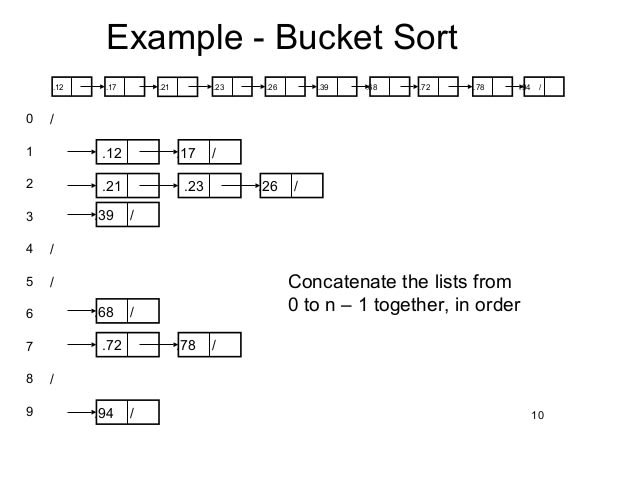Merge Sort
Merge sort is divided and conquer algorithm. It divides input array into two halves, calls itself for the two halves and then merges the two sorted halves. The merge() function is used for merging two halves. The merge(arr,l,m,r) is a key process that assumes that arr[l..m] and arr[m+l..r] are sorted and merges the two sorted sub-arrays into one.
def mergeSort(arr):
if len(arr) > 1:
mid = len(arr)
L = arr[:mid]
R = arr[mid:]
mergeSort(L)
mergeSort(R)
i = j = k = 0
while i < len(L) and j < len(R):
if L[i] < R[j]:
arr[k] = L[i]
i += 1
else:
arr[k] = R[j]
j += 1
k += 1
while i < len(L):
arr[k] = L[i]
i += 1
k += 1
while i < len(R):
arr[k] = R[j]
j += 1
k += 1
def printList(arr):
for i in range(len(arr)):
print(arr[i], end=" ")
print()
if __name__ == '__main__':
arr = [12, 11, 13, 5, 6, 7]
print("Given array is", end="\n")
printList(arr)
mergeSort(arr)
print("Sorted array is", end="\n")
printList(arr)
# Output
Given array is
12 11 13 5 6 7
Sorted array is
5 6 7 11 12 13
The below function is recursive, hence it uses function call stack to store intermediate values of l and h. The function call stack stores other bookkeeping information together with parameters. Also, function calls involve overheads like staring activation record of the caller function and then resuming execution.
def merge(left, right):
if not len(left) or not len(right):
return left or right
result = []
i,j = 0,0
while (len(result) < len(left) + len(right)):
if left[i] < right[j]:
result.append(left[i])
i += 1
else:
result.append(right[j])
j += 1
if i == len(left) or j == len(right):
result.extend(left[i:] or right[j:])
break
return result
def mergesort(list):
if len(list) < 2:
return list
middle = len(list)/2
left = mergesort(list[:middle])
right = mergesort(list[middle:])
return merge(left, right)
seq = (12, 11, 13, 5, 6, 7)
print("Given array is")
print(seq)
print("\n")
print("Sorted array is")
print(mergesort(seq))
# Output
Given array is
12 11 13 5 6 7
Sorted array is
5 6 7 11 12 13
Unlike Iterative Quick Sort, the interactive Merge Sort doesn't require an explicit auxiliary stack.
def mergeSort(a):
current_size = 1
while current_size < len(a) - 1:
left = 0
while left < len(a) - 1:
mid = left + current_size - 1
right = ((2 * current_size + left - 1,
len(a) - 1) [2 * current_size + left - 1 > len(a) - 1])
merge(a, left, mid, right)
left = left + current_size * 2
current_size = 2 * current_size
def merge(a, l, m, r):
n1 = m - l + 1
n2 = r - m
L = [0] * n1
R = [0] * n2
for i in range(0, n1):
L[i] = a[l + i]
for i in range(0, n2):
R[i] = a[m + i + 1]
i, j, k = 0, 0, l
while i < n1 and j < n2:
if L[i] > R[j]:
a[k] = R[j]
j += 1
else:
a[k] = L[i]
i += 1
k += 1
while i < n1:
a[k] = L[i]
i += 1
k += 1
while j < n2:
a[k] = R[j]
j += 1
k += 1
a = [12, 11, 13, 5, 6, 7]
print("Given array is")
print(a)
mergeSort(a)
print("Sorted array is")
print(a)
# Output
Given array is
12 11 13 5 6 7
Sorted array is
5 6 7 11 12 13
HeapSort
Heapsort is a comparison based sorting technique based on a Binary Heap data structure. It's similar to selection sort where we first find the maximum element and place the maximum element at the end.
What is Binary Heap?
A binary heap is a heap data structure that takes the form of a binary tree. Binary heaps are a common way of implementing priority queues.
A binary heap is defined as a binary tree with two additional constraints:
- Shape property: a binary heap is a complete binary tree; that is, all levels of the tree, except possibly the last one (deepest) are fully filled, and, if the last level of the tree is not complete, the nodes of that level are filled from left to right.
- Heap property: the key stored in each node is either greater than or equal to (≥) or less than or equal to (≤) the keys in the node's children, according to some total order.
Heaps, where the parent key is greater than or equal to (≥) the child keys, are called max-heaps; those where it is less than or equal to (≤) are called min-heaps. (Read more on Wikipedia)
Why array-based representation for Binary Heap?
Since a Binary Heap is a complete binary tree, it can be easily represented as an array and array-based representation is space efficient. If the parent node is stored at index 1, the left child can be calculated by 2*I+1 and right child by 2*I*2.
Heap Sort algorithm for sorting in increasing order:
- Build a max heap from the input data.
- The largest item is stored at the root of the heap. Replace it with the last item of the heap followed by reducing the size of a heap by 1. After that, heapify the root of the tree.
- Repeat the above steps while the size of a heap is greater than 1.
def heapify(arr,n,i):
largest = i
l = 2*i+1
r = 2*i+2
if l < n and arr[i] < arr[l]:
largest = l
if r < n and arr[largest] < arr[r]:
largest = r
if largest != i:
arr[i],arr[largest] = arr[largest],arr[i]
heapify(arr,n,largest)
def heapSort(arr):
n = len(arr)
for i in range(n,-1,-1):
heapify(arr,n,i)
for i in range(n-1,0,-1):
arr[i], arr[0] = arr[0], arr[i]
heapify(arr,i,0)
arr = [12, 11, 13, 5, 6, 7]
heapSort(arr)
n = len(arr)
print("Sorted array is")
for i in range(n):
print("%d" %arr[i])
# Output
Sorted array is
5 6 7 11 12 13
Counting Sort
Counting sort is a sorting technique based on keys between a specific range. It works by counting the number of objects having distinct key values. Then doing some arthmetic to calculate the position of each object in the output sequence.
def countSort(arr):
output = [0 for i in range(256)]
count = [0 for i in range(256)]
ans = ["" for _ in arr]
for i in arr:
count[ord(i)] += 1
for i in range(256):
count[i] += count[i-1]
for i in range(len(arr)):
output[count[ord(arr[i])] -1] = arr[i]
count[ord(arr[i])] -= 1
for i in range(len(arr)):
ans[i] = output[i]
return ans
arr = "Yogeswaran"
ans = countSort(arr)
print("Sorted character array is %s" %("".join(ans)))
# Output
Sorted character array is Yaaegnorsw
Radix Sort
Radix sort is a non-comparative integer sorting algorithm that sorts data with integer keys by grouping keys by the individual digits which share the same significant position and value. A positional notation is required, but because integers can represent strings of characters (e.g., names or dates) and specially formatted floating point numbers, radix sort is not limited to integers.(Source Wikipedia)
You can check the example of Radix Sort Algorithm here
Bucket Sort
Bucket sort is mainly useful when input is uniformly distributed over a range.

def insertionSort(b):
for i in range(1, len(b)):
up = b[i]
j = i - 1
while j >= 0 and b[j] > up:
b[j+1] = b[j]
j -= 1
b[j+1] = up
return b
def bucketSort(x):
arr = []
slot_num = 10
for i in range(slot_num):
arr.append([])
for j in x:
index_b = int(slot_num * j)
arr[i] = insertionSort(arr[i])
k = 0
for i in range(slot_num):
for j in range(len(arr[i])):
x[k] = arr[i][j]
k += 1
return x
x = [0.897, 0.565, 0.656,
0.1234, 0.665, 0.3434]
print("Sorted array is")
print(bucketSort(x))
# Output
Sorted array is
0.1234 0.3434 0.565 0.656 0.665 0.897
ShellSort
Shellsort, also known as Shell sort or Shell's method, is an in-place comparison sort. It can be seen as either a generalization of sorting by exchange (bubble sort) or sorting by insertion (insertion sort). The method starts by sorting pairs of elements far apart from each other, then progressively reducing the gap between elements to be compared. Starting with far apart elements, it can move some out-of-place elements into position faster than a simple nearest neighbor exchange. (Source: Wikipedia)
def shellSort(arr):
n = len(arr)
gap = n
while gap > 0:
for i in range(gap,n):
temp = arr[i]
j = i
while j >= gap and arr[j-gap] > temp:
arr[j] = arr[j-gap]
j -= gap
arr[j] = temp
gap
arr = [12, 34, 54, 2, 3]
n = len(arr)
print("Array before sorting")
for i in range(n):
print(arr[i])
shellSort(arr)
print("\nArray after sorting")
for i in range(n):
print(arr[i])
# Output
Array before sorting
12 34 54 2 3
Array after sorting
2 3 12 34 54
TimSort
Timsort is a hybrid stable sorting algorithm, derived from merge sort and insertion sort, designed to perform well on many kinds of real-world data.
- A stable sorting algorithm works in O(nLogn) time.
- USed in Java's Arrays.sort() as well as Python's sorted() and sort().
- First sort small pieces using insertion sort, then merges the pieces using merge of merge sort.
RUN = 32
def insertionSort(arr, left, right):
for i in range(left + 1, right+1):
temp = arr[i]
j = i - 1
while arr[j] > temp and j >= left:
arr[j+1] = arr[j]
j -= 1
arr[j+1] = temp
def merge(arr, l, m, r):
len1, len2 = m - l + 1, r - m
left, right = [], []
for i in range(0, len1):
left.append(arr[l + i])
for i in range(0, len2):
right.append(arr[m + 1 + i])
i, j, k = 0, 0, l
while i < len1 and j < len2:
if left[i] <= right[j]:
arr[k] = left[i]
i += 1
else:
arr[k] = right[j]
j += 1
k += 1
while i < len1:
arr[k] = left[i]
k += 1
i += 1
while j < len2:
arr[k] = right[j]
k += 1
j += 1
def timSort(arr, n):
for i in range(0, n, RUN):
insertionSort(arr, i, min((i+31), (n-1)))
size = RUN
while size < n:
for left in range(0, n, 2*size):
mid = left + size - 1
right = min((left + 2*size - 1), (n-1))
merge(arr, left, mid, right)
size = 2*size
def printArray(arr, n):
for i in range(0, n):
print(arr[i], end = " ")
print()
if __name__ == "__main__":
arr = [5, 21, 7, 23, 19]
n = len(arr)
print("Given array is")
printArray(arr, n)
timSort(arr, n)
print("After sorting array is")
printArray(arr, n)
# Output
Given array is
5 21 7 23 19
After sorting array is
5 7 19 21 23
Join my Community







Top comments (2)
Tim sort is quick if it's already sorted
Faster than "TimSort" and challenged "IntroSort".
Please read if you are interested.